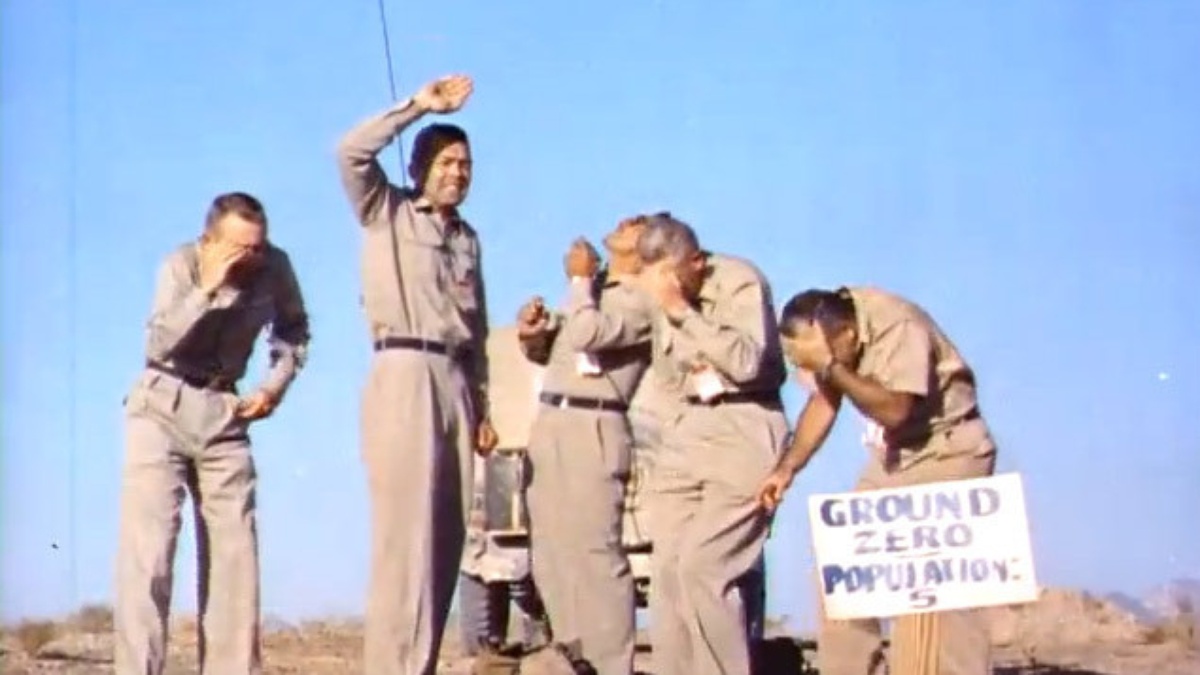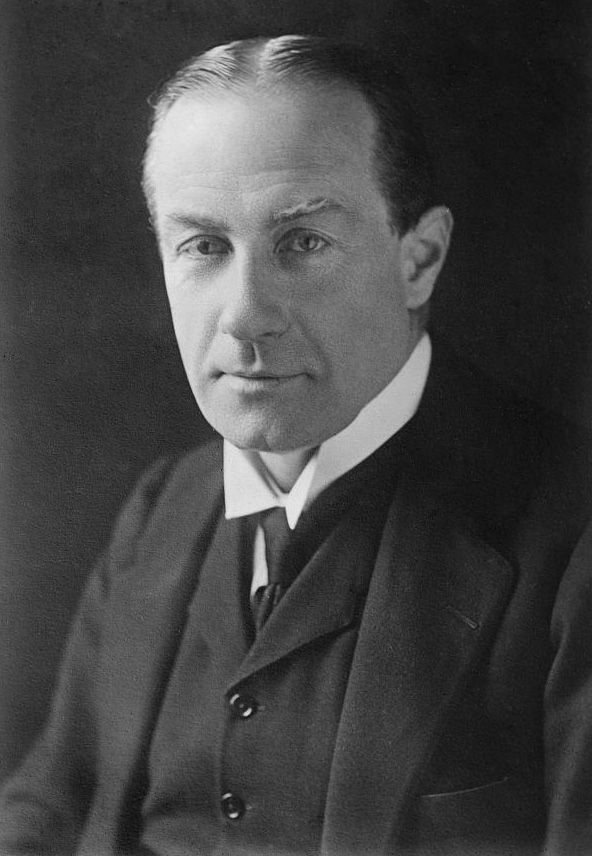The nuclear war America planned to fight over her own cities

In 1957, five volunteers wait for a 2 kiloton atomic bomb to detonate directly above them. Photo credit: screen capture from U.S. government film footage.
On July 19, 1957, six men — five volunteers and one photographer — gathered in the vast, empty desert outside Las Vegas, Nevada. They were there to wait for an atomic bomb to go off directly above them.
Their gathering was part of Operation Plumbbob, a series of nuclear tests carried out by the U.S. government between May and October of 1957. The Plumbbob tests had been ordered due to a recent shift in American nuclear doctrine. Earlier tests had focused on the impact nuclear weapons would have on enemy targets — foreign cities and military forces that found themselves on the wrong end of the American nuclear spear. Those tests had yielded a wealth of data, but they were silent on one point: what the effects would be if America set off a nuclear bomb over a friendly target — her own troops, her own cities. And now, for the first time, setting off a atomic bomb over a friendly target was something the United States government was planning to do.
Most people are familiar with the basic narrative of the Cold War: a nearly fifty-year atomic arms race between the United States and the Soviet Union, with each side stockpiling huge arsenals of nuclear weapons to deter attack from the other.
This doctrine of “deterrence” — of frightening off potential adversaries by wielding enough nuclear might to make your potential retaliation devastating — is familiar because it’s the pattern the Cold War eventually settled into. But it was not the way people thought at the beginning. When the Cold War was young, generals thought about a nuclear war as something you could fight and win. And fighting a nuclear war, to them, meant using the only tool they had at hand that could stop a nuclear weapon: another nuclear weapon.
“The bomber will always get through”
The first nuclear attacks by one nation against another took place in August 1945, when the United States dropped the bombs known as “Little Boy” and “Fat Man” on the Japanese cities of Hiroshima and Nagasaki.
Little Boy and Fat Man both reached their eventual targets in the same manner: they were hauled there in and dropped from a manned bomber aircraft. This was not an accident. The first atomic bombs were huge, heavy things — so heavy that even the biggest bomber in the American inventory, the B-29 Superfortress, could not carry Fat Man and Little Boy without extensive modifications. But the modifications were made, because in 1945, if you wanted to haul a heavy payload to an enemy city and drop it there, manned bombers were the only tool available that could do the job.
After the war’s end, this key fact remained true. The United States already had a few atomic bombs, and the Soviet Union was racing to catch up. But those bombs couldn’t be dropped without bombers, and defending against bombers was a tricky proposition.

British Prime Minister Stanley Baldwin, 1920.
Before the war, it had been widely believed that bombers were a sort of irresistible force — that no defense in existence could turn determined bombers away from their target. British Prime Minister Stanley Baldwin put forward the most eloquent expression of this opinion in a famous speech in 1932:
That is the appalling speed which the air has brought into modern warfare; the speed of the attack. The speed of the attack, compared with the attack of an army, is as the speed of a motor-car to that of a four-in-hand. In the next war you will find that any town within reach of an aerodrome can be bombed within the first five minutes of war to an extent inconceivable in the last War, and the question is, Whose morale will be shattered quickest by that preliminary bombing?
I think it is well also for the man in the street to realize that there is no power on earth that can protect him from being bombed, whatever people may tell him. The bomber will always get through.
Then came the war, and it fell to the airmen of Baldwin’s own nation to demonstrate just how wrong he had been.
The Royal Air Force invented the strategy that would defeat his assumption, combining high-performance fighter aircraft, ground-based anti-aircraft cannons, and a top-secret tool called “RADAR” to defeat Hitler’s bombers in the Battle of Britain. Then the roles reversed, and it was Nazi aviators using the same tools to inflict appalling casualties on British and American bomber forces.
Baldwin’s prediction was technically correct; some bombers always did make it through the new defenses. But the defenses could inflict such fearful casualties that attackers would lose bombers and crews faster than they could be replaced. That made the strategy of trying to knock an enemy out of the war through non-stop bombing — “strategic bombing,” the air planners called it — a Pyrrhic strategy.
Baldwin’s fear realized: A-bombs and jets
The introduction of the atomic bomb, however, changed the calculus. Suddenly the damage that had previously taken hundreds of bombers and thousands of bombs to inflict could be inflicted by one bomber, with one bomb.
That created a new dilemma for those who would defend against such attacks. Before the A-bomb, shooting down five percent of the enemy’s bombers each mission was sufficient to bleed them into inactivity. Now, though, every bomber had to be shot down. If even a single one made it through, tens of thousands of civilians on the ground could pay with their lives.
The situation was made even more complicated by the arrival near war’s end of another new technology: the jet engine.
The jet made it possible to imagine bombers, which had always been slow, lumbering beasts, that flew faster than the fighters tasked with shooting them down. (The Boeing B-47, whose design was begun late in the war, could fly at 607 miles per hour; the Convair B-58, a few years later, more than doubled that speed. The B-58 flew so fast that a special escape capsule had to be designed for it, to allow its crewmembers to survive bailing out.)
Here was the specter facing the defense planners of the early Cold War: bombers flying too fast to be shot down, of which every single one had to be shot down in order to avoid catastrophe. Clearly, something new would be needed to meet this threat.
The rocket revolution
There was a candidate to become that something new, at least in theory.
During the war, the Nazis had experimented extensively with unmanned rockets in a variety of military roles. Even the most successful of their efforts were crude, but they did prove that the idea of guiding an unmanned vehicle from a remote location was practical.
Given that, strategists wondered, what if you could use such a system to guide a small rocket, launched from the ground or from an aircraft, into an enemy aircraft?
In theory, such a missile would have advantages that made it better suited to the demands of the atomic age than more traditional weapons like manned fighters. Manned fighters were expensive, and their speed and maneuverability were both limited by the physical limitations of the human body. Missiles would be cheaper than bombers, allowing them to be deployed in greater numbers; and since they carried no pilot, they could travel even faster than the jet bombers they hunted.
However, as the scientists started to work on the problem, they discovered that a workable anti-aircraft missile would have to overcome some very difficult challenges, not least of which being that its targets would be aircraft — small targets, moving very fast. (Or, as this type of problem has been described, “hitting a bullet with another bullet.”)
With the technology of the 1940s and 1950s, these problems were hard to solve. Radar could warn of an approaching bomber, but it was too bulky to load directly onto a missile, and too imprecise to guide a missile into a fast-moving target. Human operators could guide a missile remotely, but they didn’t have the reaction times necessary to guide a missile traveling as fast as Mach 3 into a collision with a small target.
But these problems, they eventually decided, all stemmed from the same basic fact: for a missile with a conventional explosive warhead to knock down a bomber, the missile had to physically collide with the bomber itself. A near miss would not be sufficient. Which led logically to a question: what if the missile didn’t use a conventional explosive warhead? What if it used a warhead that produced an explosion so big that even a near miss would not just knock down the target, but every aircraft in the vicinity?
If you want to your missile to make a bang that big, there’s only one choice: a nuclear warhead.
So, for two decades, the American military stood ready to counter a Soviet nuclear attack with a defensive nuclear barrage of its own, right above the heads of the American people. And the Army and Air Force fought a bitter bureaucratic battle over which of them would have the privilege of setting it off.
